Acoustics: We discuss the nature of different sounds
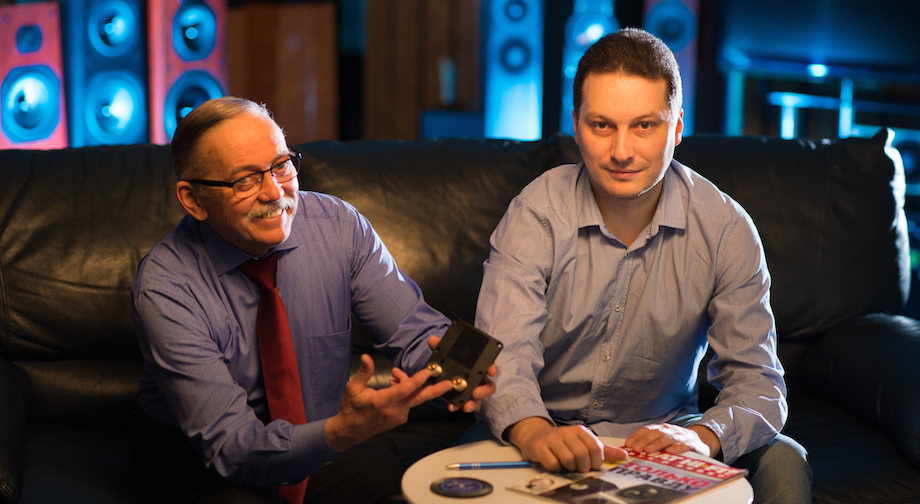
Yuri Fomin (left) and Artyom Faermark (right) / Photo Stereo.ru
In the sixteenth issue of the Sound podcast, we discuss myths related to the nature of the features of various acoustic systems with Yuri Fomin, design engineer, founder of the F-Lab company working with high-end products Defender, Jetbalance, AVE and Arslab.
[ More on the podcast ] [ Listen to this issue ]
Other Podcast Issues
- [ read ] [ listen ] Who may be interested in the development of acoustics;
- [ read ] [ listen ] Music lovers, network players and built-in acoustics;
- [ read ] [ listen ] Every engineer dreams of making an S-90;
- [ read ] [ listen ] In simple words about headphones and DACs;
- [ read ] [ listen ] Talking about vinyl: Myths, opinions and current situation;
- [ read ] [ listen ] Answers to questions from listeners of the podcast “Sound”;
- [ read ] [ listen ] We discuss the nature of the different sounds of acoustics;
- [ read ] [ listen ] Acoustics for background sounding of premises;
- [ read ] [ listen ] Answers to questions from podcast listeners;
- [ read ] [ listen ] We talk about home theaters;
- [ read ] [ listen ] Interiors for sound;
- [ read ] [ listen ] Interfaces and cables;
- [ read ] [ listen ] In simple words about digital and analog sound;
- [ read ] [ listen ] Home acoustics and answers to questions;
- [ read ] [ listen ] Engineer's opinion: How to create your own ecosystem of sound;
- [ read ] [ listen ] Quality of audio systems: Is it worth trusting “beautiful graphics” and reviews in the press;
- [ read ] [ listen ] Answers to questions of listeners;
Timofei Shikolenkov: People who are far from the Hi-Fi theme, high-quality sound often come to us. They have prejudices that all speakers sound the same. There are small, large and very large speakers, expensive and cheap.
It is not only a matter of design differences - two-way, three-way, shelf, floor; power and prices; I want to talk about the fact that the speakers really sound different, and explain to people why. How to understand the nature of this phenomenon and how to choose columns that are suitable for them.
Yuri Fomin:If you look at couples, then sometimes people wonder why this or that young man chooses for himself the unique one with which he then lives his whole life. On the one hand, this is very pathos, and on the other hand, it is very specific. And the choice of speaker system is purely individual.
There are many ways to implement systems design, but what a person likes, what he falls in love with is purely personal, inherent only to him. Many do not know, and developers hide the fact that mathematicians, psychologists, great designers have long described the existence of a sound perception curve. This curve is non-linear. We listen to sound non-linearly.
At one volume, we hear one curve, at another volume, another, and when we come to the threshold of equal volume, we hear a linear sound. If we see that the graph of the frequency response is linear, we also hear it.
The approach to designing systems is different. Sometimes the designer deliberately changes the frequency response of the system so that a person at a lower power hears a linear sound. What kind of people like this sound? Those who listen to music at the same volume as the designer. It turns out that many systems are produced, and each has a circle of its adherents, fans.
Why? There is a basic theory of the construction of linear systems. If we talk about the approach of training designers around the world, there is one approach to creating linear sound with the least loss, distortion. But the designers specifically introduce some of their elements, for this they have a lot of tools.
Timothy: It turns out that the designers intentionally distort the sound the way they like, in the hope that someone else will like it.
Yuri: Yes, they do it.
Timothy: But there is an opinion that the music from the column should sound as the sound engineer intended, no one should argue with his opinion.
Yuri:A fair opinion, considering that the one who says this is the first: he is in the studio with this director and knows what he recorded; second: that he created a similar acoustic environment for himself, and then listened to it.
The statement that it should sound like this, and not otherwise - from a number of science fiction. I am a sound engineer myself in the past and often meet with sound engineers. This is part of my life and profession. But this does not mean that I argue with the sound engineer about his vision of musical material.
He “sees” him in his own way and writes, but I listen to him next to him. How can you say, listening at home, how the music sounded in the studio?
Timothy:One can only speculate. This also applies to “concert” sound, when a person says that at home the speakers should produce the same sound as the one he heard at the concert, with the same impression.
Yuri: This situation is controversial. Much depends on the state of the listener. A slight alcohol poisoning changes the threshold of hearing and the curve. A man could hear one concert, he liked him. In a different state, he does not like the same concert. This is from the realm of mood.
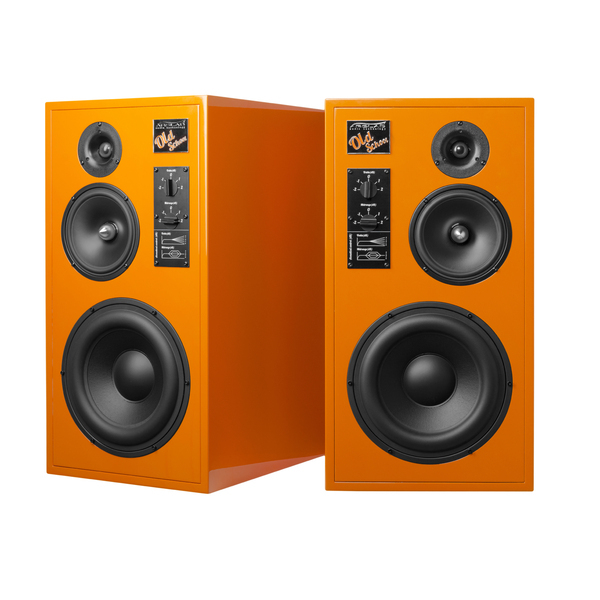
Shelf speakers Arslab Old School Superb 90 ( review )
Timothy:There are two pairs of speakers with approximately the same cost of thirty thousand rubles, both floor-mounted, large, and both have four speakers: one high-frequency, one mid-frequency and two low-frequency. Will the systems sound different?
Yuri: Ideally, under equal conditions, they should sound the same. But in fact, they will never sound the same. Why? A peculiar design approach of which we spoke is possible.
Different tools can be used. Tools are a class of speakers, a class of filters that are used in crossovers. All this will affect the sound.
Do you like the sound and what do you like? Only you can answer these questions. The designer liked what he did. If you see speakers in the store, then there is already a club of admirers of this equipment.
Timothy: Is it possible, knowing what material and technology the speaker is made in the speaker system, to imagine how it will sound if I heard the speaker system on similar speakers?
Yuri: Such problems are discussed among the participants in our workshop, I mean not only Russian engineers, but also Western ones. We sometimes talk with them about the fact that the dome speaker sounds very similar to a tape speaker.
When to apply it? Each loudspeaker, and a regular speaker is also a loudspeaker, only small, has its own parameters and capabilities. If you use them well and weave them into the canvas of the system, then the system will become organic, and you will not care what the loudspeaker costs.
Tape speakers are very lightweight and significantly faster than dome speakers. They have their advantages, but are difficult to integrate in systems, they require high qualifications [engineer]. You can understand whether you like it or not, only by turning it on and listening. Each system is a product of the creative state of a development engineer. He puts his soul into work.
Timothy:There is a myth created by people who have not heard anything about the equal sound of speakers worth ten, fifty, two hundred thousand rubles. Allegedly, there is no difference in sound, people themselves came up with to justify spending on speakers.
It is clear that there is a cost to the components, one can proceed from this, but the issue is not only in the components. How can I try to explain the impression of the sound of speakers of different classes?
Yuri: I will draw an analogy. A student of a paid university discusses the competence of a lecturer teaching him. It is unclear why he came and pays for training, because there are no other lecturers and, in general, why is he at a university?
Budget systems are made, if not on a residual basis, then very tightly on the level of those components that are integrated there. The budget system cannot have expensive high-quality speakers.
If the company grows, it can go on to give up part of the superprofit, or simply profit, and do it on the verge of the possible, that is, sell it at cost. But, when you buy a system for two hundred, and not for ten thousand rubles, there, as a rule, much better components are used there, which, accordingly, will sound better.
What are the parameters to evaluate the speakers? An engineer integrates them into the system not at a price, but at the totality of those parameters that all speakers have in order to find a single whole, and not just a good tweeter, a good mid-range speaker or good bass. This is his vision.
The price category allows him to integrate and be able to select components from more expensive series, more expensive companies. These arguments are similar to the arguments that the Lada is better than Mercedes, because I can fix them.
Timothy: Perhaps, in this case, [Lada will be] better if the person has the task to repair them.
Yuri:Let us recall Zhvanetsky: “They mastered the form, it would be nice to content!” People have the means to buy expensive cars. And what is the approach to the issue? Ride or show off? It is necessary to conduct an inspection of himself.
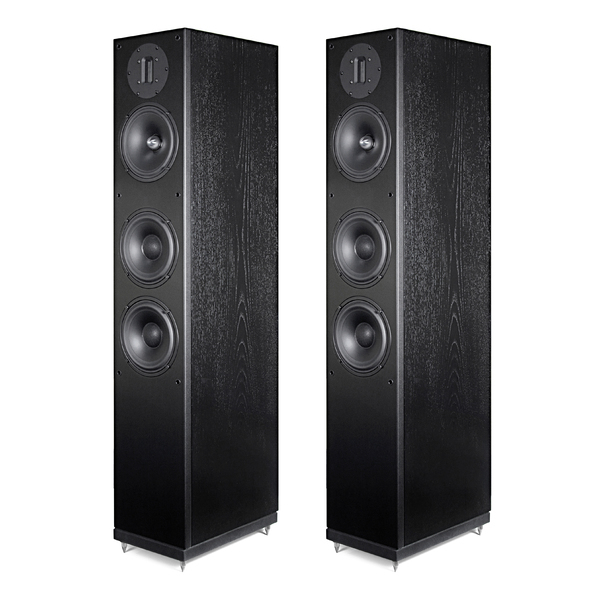
Outdoor speakers Arslab Classic 3 SE ( review )
Timofei: There is a contradictory parameter from the set of technical characteristics of acoustic systems, which is often talked about: the range of reproduced frequencies. Cheap speakers always boast an indication of 20 Hz - 20 kHz.
And the townsfolk, who are not aware that there are different classes of equipment, that they sound different, and their impression is different, focus on the technical characteristics that they are shown on the sites.
Talk about the frequency range, we have already touched on the topic of frequency response. I’m not sure that all of our listeners know what the frequency response is.
Yuri: This is an amplitude-frequency characteristic. Classically, it should be smooth and should capture a conventionally accepted range from 20 Hz to 20 kHz. So [the question] is interpreted by classical science, but I want to reassure: firstly, the system, no matter which speakers, theoretically cannot play 20 Hz, and those that can play cannot cost ten thousand rubles.
This is an almost impossible task. I understand what requirements loudspeakers must have in order to hook this range at least in recessions. These will be very complex speakers and very expensive, precisely because they are complex. They themselves should have a resonance in the region of 10-15 Hz, but I can count them on the fingers, in general, in the world, throughout history.
In this case, many physical parameters conflict. A heavy speaker cannot have high sound pressure. You need to understand: what is written in the parameters is often a marketing move in order not to differ from competitors.
I met this and I see nothing wrong with that, because if everyone violates the law, then everyone violates it the same way. Such is the unspoken opinion. Another question is 20 kHz. Now 20 kHz all tweeters are playing. Another question is how?
They will draw a line necessarily, but a wider range is needed. Interestingly, this is reflected in the bass. This is few who imagine. But the range must be wide, because a person does not hear at 20 kHz, but he distinguishes this [sound].
There are other categories of assessment - not the analysis of frequency response, but the analysis of impulse responses. Analysis of the attack of the sound itself - the further it goes, the better the pulse is recorded - the slew rate of the signal in the speaker. This is the breadth of the range.
Reliability, detail depends on speed: the further, the better. We do not hear this, but we understand. Our analytical apparatus evaluates sound according to a very large number of criteria. This is not only frequency response.
Timothy: Do you need to introduce such a characteristic as speed?
Yuri:Amplifiers have a slew rate. She is very important, people understand this and follow her. In acoustic systems, one should pay attention to the following: if the system is more broadband, the slew rate of the signal depends on this parameter quite seriously. There is another factor - this is the weight of mobile systems. The main high-frequency front - the slew rate - depends on the width of the range: the farther, the "faster."
Timothy: If we return to the point where we started the discussion of this issue - the frequency characteristics, it turns out that those who write from 20 Hz to 20 kHz just lie?
Yuri:They don’t lie, if only because the system will play 20 Hz. The question is, with what recession? It can be 12 decibels, and this, in fact, is not heard. Why do we say: hear or not hear? We hear fluctuations all the time.
For example, in the morning I go out into the street, the phrase “the air rings” is very suitable and you can hear the road that is ten kilometers away from me, but I don’t hear it in the afternoon. In the morning, the noise level in the courtyard is very low, and I hear that noise that is very far away, and in the afternoon the noise level in the courtyard is very high, and I can no longer hear what is going on for ten kilometers.
This is how we are arranged, and so does the “volume knob” in our head. If you want to hear 20 Hz, then you will hear them if you are in a completely quiet room, which is almost impossible.
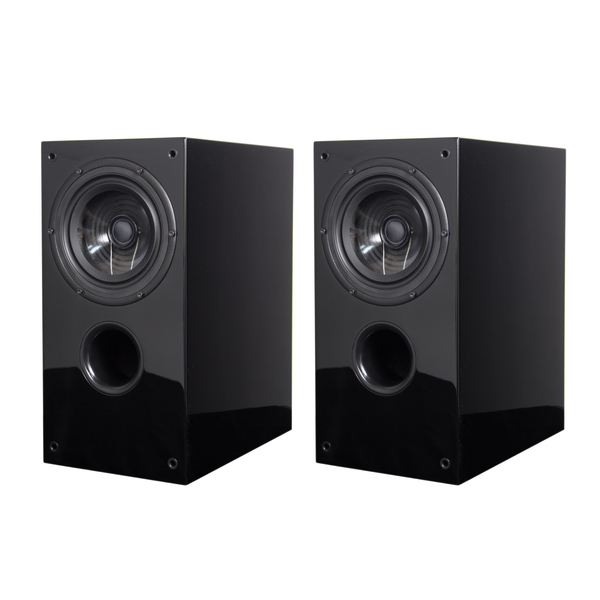
Shelf speakers Arslab Monitor M1 (review )
Timothy: Even for expensive systems?
Yuri: Of course. I, as an engineer, responsibly declare to you that this system is extremely difficult to implement.
Timothy: Does it need to be implemented?
Yuri: The question is good. I know for sure that a person below 30 Hz does not hear with his ear. He can feel the sound in the form of pressure drops. The requirements for sound pressure so that you physically feel it are very high, and it is impossible to implement them either by large or small speakers that are used in everyday life.
If you put on a concert speakers that play 20 Hz at a distance of fifty meters, you will not hear anything. Therefore, "forests" are set up. You do not hear 20 Hz, but you hear the difference in sound pressure. It puts pressure on your chest, or, as they say, "the liver is shaking." There is no hearing aid involvement.
Timothy: Back to the applied topic. There are people who do not have the opportunity to listen to acoustics, if they live in remote regions, there are no shops, no salons, or showrooms. Can they remotely, can, looking at the photo or reading the characteristics, make a conclusion about the sound of the equipment? Is it possible? Give some advice.
Yuri:The advice is to trust the brand. A self-respecting brand carries its sound throughout life. The sound does not change, only the components that are placed in these systems change. They [systems] can be very inexpensive, not very expensive and very expensive. In all cases, they will sound almost the same.
Timothy: How so?
Yuri: How can expensive and inexpensive systems differ? They can produce one frequency response and, formally, you hear the same sound, it can have more or less distortion.
How much can you neglect these distortions? For a sophisticated listener, it is important that there is little distortion, so he is forced to buy an expensive system.
A person to whom sound distortion is not so important, or who quenches his receptors in the circle of friends with beer, hears only the sounding character, and it is the character who is important. The manufacturing company guarantees this character, it is her face.
Timothy: Even if the speakers change?
Yuri: Right. It does not matter, small, large, medium columns, the character should remain the same.
Timothy: Branding.
Yuri:That's right, as an artist. By brushstroke and manner of writing, we recognize the picture of Rembrandt. Many people understand Mane because they have studied his handwriting well. So it is here. Each developer has tools to create their own character. It's good. Otherwise, we would have one column or one company, and it would produce the same systems. There would be no choice.
Timothy: It turns out that listening is the ideal option.
Yuri: Unfortunately, yes. You can also choose a wife for yourself from the photograph. Again, I'm talking about this. I chose from a photograph, she cooked dinner, it turned out - not that. That’s the whole choice.
Ultimately, everything goes to personal contact. On the other hand, we can take as an example the Russian proverb: "an apple does not fall far from an apple tree." “Apple tree” is a company, “apples” fall under it, and all “apples” are the same.
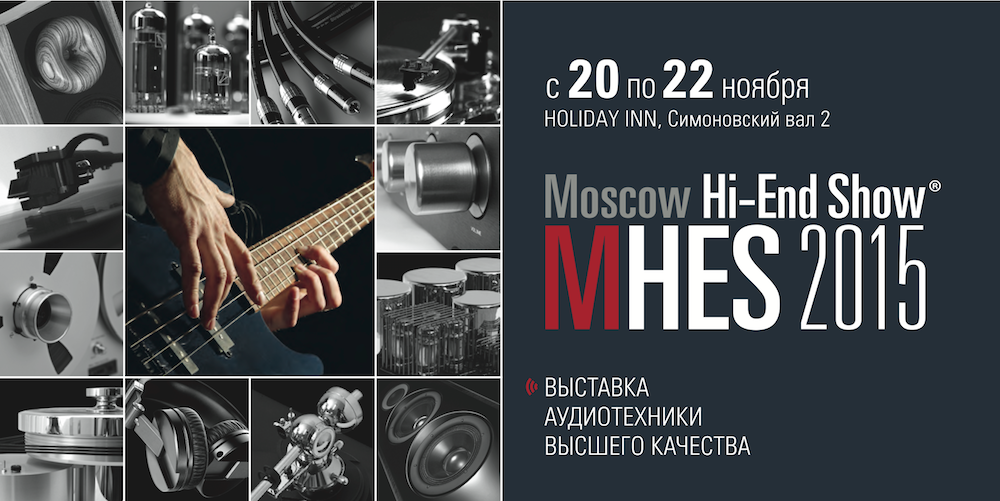
Invitation card to the Moscow Hi-End Show 2015
Timofei: Let's talk about why the same speakers can sound different with different amplifiers, even of the same class and about the same price.
Yuri: If we talk about amplifiers of equal price, we take the following as a basis: the design bureau enters the market, and he needs to sell his goods. By what criteria can he sell it? By the nature of the sound. And how is it achieved?
Circuitry solutions are rather narrow, and there are not many of them. Decisions are being weighed. How to earn money? A logistic decision is made regarding the components that are put there. If you make a good power source for the amplifier, a very large transformer, a lot of capacitors that will stand as buffers, then the amplifier will be very expensive. Therefore, you need to save money, you need to throw away part and make the transformer smaller.
But it is necessary to compensate for this loss circuitry. Someone does it well, while others do not. Someone makes uncompromising amplifiers, but they are very expensive. And deservedly. To take even the case turned from aluminum is expensive. Everything is intertwined. If people choose in the same price category, then, as they say, what you like, then take it.
Timothy:Again a compromise. It is necessary to find out what the developer of this particular amplifier saved on.
Yuri: It is a serious job to analyze why this is done?
Timothy: Published photos of the amplifier with an open cover say nothing?
Yuri: They can say about the size of the transformer and the number of capacitors. We can draw the following conclusion: if a small transformer and a small number of capacitors, the source does not have a sufficient supply, but this does not mean that it sounds bad.
If there is a pulsed source, then it is invisible in the photograph, and its energy is like that of a huge capacitor. Another question is how high-quality it is, because it is a source of noise. How did the company deal with these issues, what solutions did it have, how did it clear the path from the noise created by an imperceptible pulse source in the photo?
Timofey: It is very interesting to look at the characteristics of the output power and compare them with the power consumption.
Yuri: It all depends on the efficiency of the amplifier. For example, a pulsed source has a very high efficiency, it can consume 100 watts and give a system of 90 watts. Claimed - 100 watts, consumed - 100 watts, expected - 100 watts. This will never happen. You need to reason sensibly!
Timothy:It turns out that one should look at the characteristics with caution.
Yuri: Yes, you need to look, understanding their essence. People understand what the engine power of a car is. And we can figure out our question.
Timothy: With the power of the car, everything is simple: here is the figure, and here is the power.
Yuri: And it’s easy here. We look at the declared power, then at the one that it consumes from the network. We conclude that there will never be more values than the last digit.
Timofei: Regarding the nature of the sound ...
Yuri: Very individually. As in acoustic systems, each engineer decides on the nature of the sound of amplifiers in their own way. There are few ways of implementation, because circuitry decisions were made back in the 70s.
Now they are turned over, reduced, added. There are no revolutions to exclaim: “Ah!” The only thing that can be called a breakthrough is the availability of high-end digital amplifiers. Previously, they were not at a high level, but now they have a very high level of sound.
They sound pretty well. They are compact, lightweight, powerful, and give off just as much as they consume. This is a promising area, and after a while, classical amplifiers will be perceived as vinyl - for lovers of classic solutions. Digital amplifiers will supplant all others, especially in the middle segment. This is my guess.
Timothy: Is there really a minus? Are technologies improving in this direction?
Yuri:Less and less. People are "locked up" on this. There are more successes than defeats. In "pro" systems, I prefer digital amplifiers, they weigh nothing, and work better than usual.
Timothy: We have come to the conclusion that we need to listen to our sound with our own ears. It’s useless to choose according to characteristics, according to pictures.
Yuri: Yes. I want to warn people again against using someone else’s opinion.
